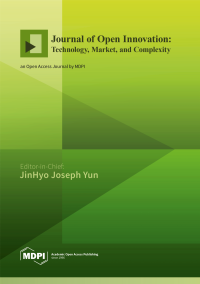The 4th Industrial Revolution from Open Innovation in Manufacturing and Service Industry to Cyber-Physics
A special issue of Journal of Open Innovation: Technology, Market, and Complexity (ISSN 2199-8531).
Deadline for manuscript submissions: closed (31 December 2018) | Viewed by 213319
Special Issue Editors
Interests: open innovation; business model; open innovation economy; social open innovation; Schumpeterian dynamics; complexity; game theory; political economics
Interests: inter-firm collaboration; strategic networks; coopetition; tourism management; dynamic capabilities; value creation and appropriation; value co-creation; industry 4.0; open innovation
Special Issue Information
Dear Colleagues,
This special issue will publish some selected papers from annual conference of SOItmC 2018. Suitable topics include but are not limited to the following:
- Open Innovation
- Business Model
- Schumpeterian Economics
- Complex economics
- Open Service Innovation
- Cyber-Physics
The Article Processing Changes (APC) of the first 24 accepted papers including Keynotes from the planned paper list will be supported by payment from DGIST (SOItmC) to MDPI. Authors of these paper should include an acknowledgement following one of the two examples below:
(1) This paper received the ‘best paper award’ at SOItmC 2018 conference, and the publishing fee was supported by DGIST (DGIST-IT-18-01)
(2) This paper was presented as a keynote speech at SOItmC 2018, and the publishing fee was supported by DGIST (DGIST-IT-18-01)
With the exception of the nine keynote speech papers, papers which were selected at JOItmC to form a Special Issue of SOItmC 2018 will be recommended for the Best Paper Award of SOItmC 2018.
Dr. JinHyo Joseph Yun
Dr. Valentina Della Corte
Guest Editors
Manuscript Submission Information
Manuscripts should be submitted online at www.mdpi.com by registering and logging in to this website. Once you are registered, click here to go to the submission form. Manuscripts can be submitted until the deadline. All submissions that pass pre-check are peer-reviewed. Accepted papers will be published continuously in the journal (as soon as accepted) and will be listed together on the special issue website. Research articles, review articles as well as short communications are invited. For planned papers, a title and short abstract (about 100 words) can be sent to the Editorial Office for announcement on this website.
Submitted manuscripts should not have been published previously, nor be under consideration for publication elsewhere (except conference proceedings papers). All manuscripts are thoroughly refereed through a single-blind peer-review process. A guide for authors and other relevant information for submission of manuscripts is available on the Instructions for Authors page. Journal of Open Innovation: Technology, Market, and Complexity is an international peer-reviewed open access quarterly journal published by MDPI.
Please visit the Instructions for Authors page before submitting a manuscript. The Article Processing Charge (APC) for publication in this open access journal is 800 CHF (Swiss Francs). Submitted papers should be well formatted and use good English. Authors may use MDPI's English editing service prior to publication or during author revisions.





